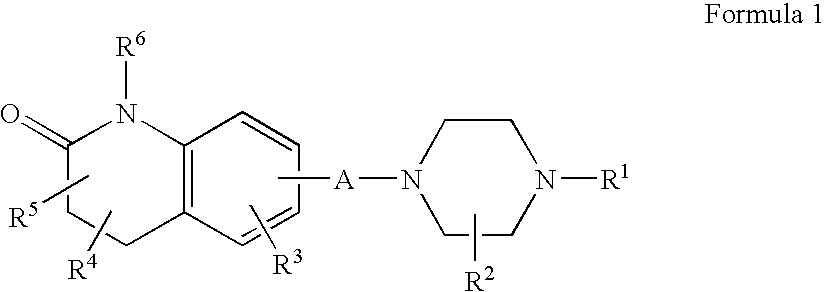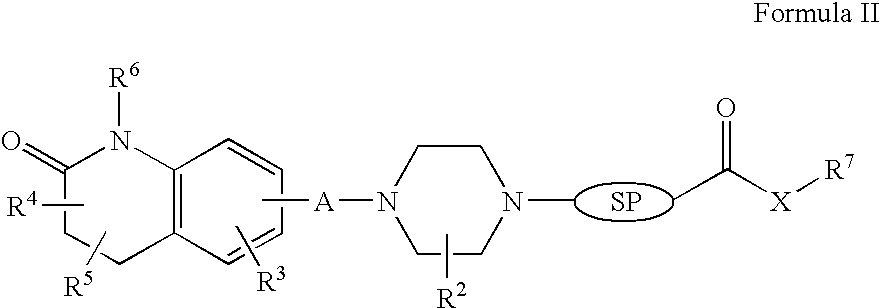Compositions, Synthesis, and Methods of Using Quinolinone Based Atypical Antipsychotic Agents
a technology of quinolinone and atypical antipsychotic agents, which is applied in the field of compositions of quinolinone derivatives and synthesis of quinolinone derivatives, can solve the problems of marked limitation of use of both risperidone and olanzapine, adverse side effects of both drugs, and poor liver and kidney function, so as to achieve more effective and safer treatment, the effect of reducing side effects
- Summary
- Abstract
- Description
- Claims
- Application Information
AI Technical Summary
Benefits of technology
Problems solved by technology
Method used
Image
Examples
example 1
7-(4-Bromobutoxy)-3,4-dihydroquinolinone-2(1H)-one (3) (Scheme 1)
[0218]To a stirred suspension of anhydrous potassium carbonate (K2CO3) (10.50 g, 0.075 mol) in 100 mL of anhydrous N,N-dimethylformamide (DMF) was added 7-hydroxyquinolinone 1 (10.00 g, 0.06 mol) followed by 1,4-dibromobutane 2 (25.91 g, 0.12 mol). The resulting mixture was heated at 60° C. for 12 h. The progress of the reaction was monitored by thin layer chromatography (TLC) technique. After cooling to room temperature, the reaction mixture was filtered through a sintered funnel and the precipitate was washed with ethyl acetate (25 mL×2). The combined filtrate was concentrated on a rotavapor. The residue was diluted with 250 mL of ethyl acetate, washed with water (100 mL×2), dried over anhydrous magnesium sulfate and evaporated the solvent. The residue was triturated with hexane and then filtered the precipitate to give the pure title compound 3. White solid, 12.88 g (72%). 1H NMR (400 MHz, CDCl3): δ 1.92-1.97 (m, 2H...
example 2
7-(4-(4-(2-Methoxyphenyl)piperazin-1-yl)butoxy)-3,4-dihydroquinolin-2(1H)-one (5) (Scheme 1)
[0219]To a mixture of 7-(4-bromobutoxy)-3,4-dihydroquinolin-2(1H)-one (3) (13 g, 0.0437 mol) and the commercially available (purchased from Sigma-Aldrich) 1-(2-methoxy-phenyl)piperazine hydrochloride (4) (0.0437 mol) in 60 mL anhydrous acetonitrile at ice-bath temperature was added N,N-diisopropylethylamine (DIEA) (19 mL, 0.11 mol). The resulting mixture was refluxed for overnight (12 h). The progress of the reaction was monitored by thin layer chromatography (TLC). The reaction mixture was concentrated on rotavapor, the residue was dissolved in dichloromethane (150 mL), washed with water (100 mL×2), dried over sodium sulphate (Na2SO4) and evaporated under reduced pressure. The residue was triturated with methyl tert-butyl ether (MTBE) and filtered to give the corresponding quinolinone 5. White solid, 12.4 g (70%). 1H NMR (400 MHz, CDCl3): δ 1.64-1.86 (4H, m); 2.55 (t, J=9.2 Hz, 2H); 2.63 (t,...
example 3
7-(4-(4-(2-Hydroxyphenyl)piperazin-1-yl)butoxy)-3,4-dihydroquinolin-2(1H)-one (6) (Scheme 1)
[0220]To a solution of 7-(4-(4-(2-methoxyphenyl)piperazin-1-yl)butoxy)-3,4-dihydroquinolin-2(1H)-one (5) (6.3 g, 0.015 mol) in 24 mL dichloromethane and 24 mL ethanethiol cooled to ice-bath temperature was added aluminum chloride (6.15 g, 0.046 mol) in small portions. The resulting mixture was stirred at room temperature for 12 h. The progress of the reaction was monitored by thin layer chromatography (TLC). The reaction mixture was decanted and the sticky mass was dissolved in water by stirring for 1 h. The pH of the resulting aqueous solution was adjusted to pH=7 by adding 2M sodium hydroxide (NaOH) solution. Copious amount of acetone was added and the resulting thick paste was filtered and washed with acetone followed by dichloromethane, the combined filtrate was evaporated. The residue was purified by silica gel column chromatography using 0-100% gradient of hexanes and ethyl acetate to g...
PUM
| Property | Measurement | Unit |
|---|---|---|
| enantiomeric excess | aaaaa | aaaaa |
| enantiomeric excess | aaaaa | aaaaa |
| enantiomeric excess | aaaaa | aaaaa |
Abstract
Description
Claims
Application Information
 Login to View More
Login to View More - R&D
- Intellectual Property
- Life Sciences
- Materials
- Tech Scout
- Unparalleled Data Quality
- Higher Quality Content
- 60% Fewer Hallucinations
Browse by: Latest US Patents, China's latest patents, Technical Efficacy Thesaurus, Application Domain, Technology Topic, Popular Technical Reports.
© 2025 PatSnap. All rights reserved.Legal|Privacy policy|Modern Slavery Act Transparency Statement|Sitemap|About US| Contact US: help@patsnap.com



